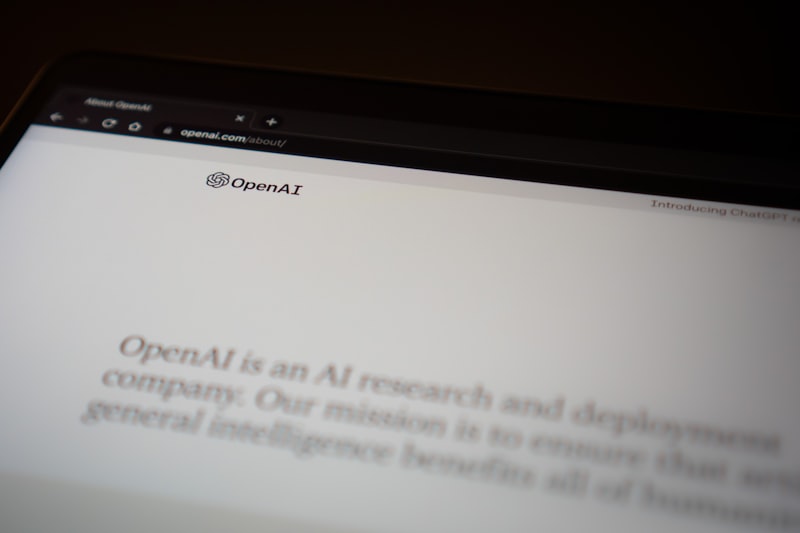Are you wondering how to feed information to ChatGPT? Well, you’ve come to the right place! In this article, we’ll explore some effective ways to provide input to this incredible language model. Whether you’re a developer or a curious user, these tips will help you make the most out of your interactions with ChatGPT.
First and foremost, it’s important to understand that ChatGPT is trained on a vast amount of data, but it doesn’t have real-time access to the internet. So, if you want to provide specific information, you need to include it in your conversation. You can simply start by stating the facts, asking questions, or making declarative statements.
For example, let’s say you want to know about the tallest mountain in the world. Instead of just saying “Tell me about the tallest mountain,” you could ask something like, “What is the name of the tallest mountain, and how tall is it?” This gives ChatGPT a clear context and makes it easier for it to provide an accurate response.
Another useful technique is to break down complex queries into simpler ones. Instead of bombarding ChatGPT with a long, convoluted question, try asking one part at a time. For instance, if you’re interested in the history of a city, you could start by asking about its founding year, then follow up with separate questions about significant events or famous landmarks.
It’s also worth remembering that ChatGPT responds well to specific examples. When seeking information, consider providing concrete details to illustrate your point. Instead of asking for general advice on cooking, try asking for a recipe for a specific dish or inquire about the best ingredient substitutions for a particular dietary restriction.
Lastly, don’t forget to engage with ChatGPT in a conversational manner. Treat it as though you’re having a friendly discussion. By using personal pronouns and an informal tone, you create a more natural and enjoyable experience.
Feeding information to ChatGPT is as simple as including it in your conversation. Be clear and specific, break down complex queries, use concrete examples, and maintain a conversational tone. By following these guidelines, you’ll enhance your interactions with ChatGPT and uncover the wonders of this remarkable language model.
Unlocking the Secrets: 10 Expert Tips on Feeding ChatGPT with Information
Contents
- 1 Unlocking the Secrets: 10 Expert Tips on Feeding ChatGPT with Information
- 2 Mastering the Art of Nourishing ChatGPT’s Knowledge Base: 10 Key Strategies Revealed
- 3 From Data to Brilliance: 10 Effective Ways to Feed ChatGPT with Information
- 4 Fueling the AI Mind: 10 Cutting-Edge Techniques for Feeding ChatGPT Knowledge
Are you ready to unravel the mysteries behind effectively feeding information to ChatGPT? Look no further! In this article, we will delve into the depths of unleashing the full potential of ChatGPT by providing you with 10 expert tips that will revolutionize your interaction with this remarkable language model.
-
Start with a Clear Objective: Clearly define your goal before engaging with ChatGPT. Whether you seek creative ideas or factual information, having a specific objective in mind will help guide your conversation and yield more accurate results.
-
Ask Focused Questions: Structure your questions in a precise and concise manner. Instead of asking open-ended queries, break them down into smaller, more targeted questions. This approach allows ChatGPT to grasp the essence of what you’re looking for and provide more relevant answers.
-
Provide Context: Context is key! When interacting with ChatGPT, furnish it with relevant background information to ensure a better understanding of your inquiries. Giving context helps ChatGPT generate more accurate and tailored responses.
-
Experiment with Prompts: Don’t shy away from experimenting with different prompts. Varying the way you phrase your questions or instructions can yield diverse perspectives and uncover hidden insights within ChatGPT’s vast knowledge base.
-
Utilize System Messages: Take advantage of system messages to guide ChatGPT during the conversation. These messages act as gentle nudges, steering the model in the desired direction and helping it produce responses that align with your objectives.
-
Provide Corrective Feedback: ChatGPT learns from corrections! If it generates an incorrect or unsatisfactory response, don’t hesitate to provide corrective feedback. By highlighting mistakes, you help the model improve its future responses.
-
Engage in Iterative Feedback: Iteration is key to refining ChatGPT’s performance. Engage in a back-and-forth dialogue, gradually refining your queries and prompts based on the model’s responses. This iterative process enhances the quality and relevance of the generated content.
-
Leverage ChatGPT’s Strengths: Recognize ChatGPT’s expertise in certain domains and leverage it accordingly. The model performs exceptionally well in providing creative ideas, explanations, and summaries. Use these strengths to your advantage when seeking information.
-
Stay Curious: Curiosity fuels discovery! Maintain an inquisitive mindset and explore different angles and topics while interacting with ChatGPT. Embrace the serendipitous nature of the model’s responses, as it can lead to unexpected insights and valuable discoveries.
-
Ethical Considerations: Remember that ChatGPT is a tool and not a human. Exercise ethical judgment when using the generated content. Avoid promoting misinformation, bias, or engaging in inappropriate conversations. Responsible usage ensures the positive impact of this powerful language model.
Now armed with these expert tips, you’re ready to unlock the secrets of feeding ChatGPT with information. Embrace the potential of this incredible tool and embark on a journey of knowledge, creativity, and discovery like never before!
Mastering the Art of Nourishing ChatGPT’s Knowledge Base: 10 Key Strategies Revealed
Are you ready to unlock the true potential of ChatGPT’s knowledge base? In this article, we will unveil ten powerful strategies that will help you master the art of nourishing ChatGPT’s vast repository of information. These techniques will not only enhance its capabilities but also ensure you obtain accurate and relevant responses to your queries.
-
Dive into Diverse Content:
Immerse ChatGPT in a wide range of topics. From science to history, technology to arts, expose it to a varied collection of information. This broadens its understanding, enabling it to provide well-rounded insights on numerous subjects. -
Incorporate Real-World Examples:
Nothing resonates more with humans than real-life examples. Similarly, providing ChatGPT with concrete instances from different domains enhances its contextual understanding, making its responses more relatable and impactful. -
Encourage Critical Thinking:
Challenge ChatGPT by posing thought-provoking questions. Engage in conversations that demand logical reasoning and deep analysis. This exercise stimulates its cognitive abilities, refining its responses and encouraging a more nuanced approach. -
Leverage Feedback Loop:
Feedback is invaluable for improvement. Offer constructive feedback when ChatGPT provides inaccurate or irrelevant answers. By doing so, you assist in reinforcing its knowledge base, rectifying any misconceptions, and fine-tuning its responses. -
Embrace Contextual Prompts:
ChatGPT thrives on context. Provide specific details and prompts that outline the desired scope of the conversation. This allows it to generate responses tailored to the given context, resulting in more precise and coherent answers. 
Explore New Perspectives:
Just like humans, ChatGPT benefits from exposure to diverse viewpoints. Introduce it to different cultures, ideologies, and philosophies. This widens its perspective, enabling it to offer insights from various angles, fostering a more comprehensive understanding.-
Capitalize on External Knowledge:
While ChatGPT possesses a vast internal knowledge base, it can also utilize external sources for information retrieval. Encourage it to refer to trusted references, books, articles, and databases. This enriches its responses with up-to-date and accurate information. -
Foster Multimodal Learning:
Enhance ChatGPT’s learning experience by incorporating multimodal inputs. Combine text with images, audio, or video to provide a holistic learning environment. This helps it grasp concepts more effectively and generate well-rounded responses. -
Capture the Essence of Analogies:
Analogies are powerful tools for comprehension. Employing them in conversations with ChatGPT enhances its ability to understand complex concepts by drawing parallels to familiar scenarios. This empowers it to provide clearer and more insightful explanations. 
Stay Curious, Keep Exploring:
The learning journey never ends. Continuously explore new subjects with ChatGPT, ask probing questions, and encourage an inquisitive mindset. By fostering curiosity, you fuel its hunger for knowledge, ensuring an ever-expanding knowledge base.
By employing these ten key strategies, you hold the key to unlocking ChatGPT’s true potential. Nourishing its knowledge base through diverse content, real-world examples, critical thinking, feedback loops, contextual prompts, and continuous exploration will elevate its capabilities to astounding heights. Embrace these techniques, and prepare to witness the amazement as ChatGPT astounds you with its enriched knowledge base.
From Data to Brilliance: 10 Effective Ways to Feed ChatGPT with Information

Are you looking to unleash the full potential of ChatGPT? Want to fuel its brilliance and enhance its capabilities? Then, you’ve come to the right place! In this article, we’ll explore ten effective ways to feed ChatGPT with information, transforming it into an even more powerful conversational partner.
-
Dive into Diverse Data Sources:
To enrich ChatGPT’s knowledge, expose it to a wide range of data sources. Incorporate diverse articles, books, blogs, academic papers, and reputable websites. By feeding it with varied information, you provide ChatGPT with a broader understanding of different subjects. -
Harness the Power of Context:
Context is key! When providing input to ChatGPT, consider including relevant details about the topic at hand. By setting the context, you enable ChatGPT to generate more accurate and coherent responses that align with the desired subject matter. -
Fine-tune for Specific Domains:
If you have a specific domain in mind, fine-tuning ChatGPT can work wonders. By training it on data from your chosen field, such as medicine or finance, you can create a highly specialized conversational expert tailored to your needs. -
Employ Exemplars and Comparisons:
To guide ChatGPT’s responses, use exemplars and comparisons. Provide examples of high-quality answers to help ChatGPT understand the expected output. Additionally, using analogies and metaphors can aid in conveying complex concepts effectively. -
Emphasize Ethical Guidelines:
As you feed ChatGPT with information, keep ethical considerations in mind. Make sure the data you provide adheres to ethical standards, avoiding biased or harmful content. Responsible feeding ensures ChatGPT generates responsible and unbiased responses. -
Encourage Feedback Loop:
Creating a feedback loop with ChatGPT can lead to continuous improvement. Evaluate its responses, correct any mistakes, and provide constructive feedback. This iterative process helps ChatGPT refine its understanding and produce more accurate and relevant outputs. -
Optimize for Simplicity and Clarity:
Keep it simple! Use plain language and concise sentences when inputting information. By avoiding jargon and complex structures, you enable ChatGPT to generate user-friendly and easily understandable responses. -
Stay Up-to-Date:
The world is constantly evolving, and so should ChatGPT’s knowledge base. Regularly update the information you feed ChatGPT to keep it current and ensure it can provide up-to-date insights and responses. -
Leverage User Interactions:
Take advantage of user interactions with ChatGPT. Analyze and learn from real conversations to enhance its conversational abilities. Pay attention to user feedback and incorporate it into the training process to continuously improve ChatGPT’s performance. -
Explore Reinforcement Learning:
Reinforcement learning can take ChatGPT’s capabilities to new heights. Train ChatGPT using reinforcement techniques to reinforce positive behavior and responses. This approach allows ChatGPT to learn from its own experiences and further refine its conversational skills.
Feeding ChatGPT with information is a transformative process that can unlock its brilliance. By diversifying data sources, providing context, and fine-tuning for specific domains, you empower ChatGPT to generate more accurate and informed responses. Remember to prioritize ethical guidelines, embrace a feedback loop, and optimize for simplicity and clarity. Additionally, staying up-to-date, leveraging user interactions, and exploring reinforcement learning are crucial steps towards maximizing ChatGPT’s potential. Now, go ahead and fuel ChatGPT with knowledge to witness its true brilliance in action!
Fueling the AI Mind: 10 Cutting-Edge Techniques for Feeding ChatGPT Knowledge
Artificial Intelligence (AI) has made significant strides in recent years, and one of its most impressive achievements is the development of language models like ChatGPT. These advanced systems have the ability to generate human-like text and engage in meaningful conversations. But have you ever wondered how ChatGPT acquires its knowledge? In this article, we’ll delve into the fascinating techniques used to fuel the AI mind and enhance its capabilities.
-
Web Crawling: Similar to search engines, ChatGPT can crawl the web to gather information from various sources. It scours websites, reads articles, and assimilates a vast amount of data to expand its knowledge base.
-
Text Corpus: A diverse collection of text documents helps ChatGPT understand language patterns and acquire a broad range of topics. By analyzing books, articles, and other written materials, it gains insights that contribute to its linguistic prowess.
-
Question-Answer Pairs: ChatGPT learns through question-and-answer interactions, where it receives prompts and generates relevant responses. This iterative process fine-tunes its understanding and improves its ability to provide accurate answers.
-
User Feedback: Feedback from users plays a crucial role in refining ChatGPT’s performance. By leveraging user corrections and ratings, the AI system can identify and rectify errors, ensuring continuous learning and improvement.
-
Pretraining and Fine-Tuning: ChatGPT undergoes pretraining on a large corpus of publicly available text data. Following that, it goes through a fine-tuning process using custom datasets created by OpenAI. This two-step training approach enables the model to adapt to specific tasks and exhibit more targeted behavior.
-
Language Translation: Translating text between languages aids ChatGPT in cross-lingual understanding. By comprehending different languages, it can access a wider range of knowledge and engage with users from diverse linguistic backgrounds.
-
Dialogue Datasets: Engaging in dialogues is a valuable learning experience for ChatGPT. Using dialogue datasets, it learns conversational dynamics, context retention, and the art of engaging people in meaningful discussions.
-
Simulated Conversations: ChatGPT benefits from simulated conversations, where it assumes both user and AI roles. By playing out different scenarios, it gains insights into potential user queries, enhancing its ability to generate informative and relevant responses.
-
Expert Knowledge Injection: OpenAI injects specific knowledge into ChatGPT manually to ensure accurate and reliable information. This curated information helps the model handle queries that require specialized domain expertise.
-
Continuous Learning: ChatGPT is designed to learn continuously from new data. As more conversations take place and more information becomes available, the model evolves and adapts, staying up-to-date with the latest trends and knowledge.
Fueling the AI mind of ChatGPT involves an array of cutting-edge techniques that contribute to its remarkable abilities. From web crawling and user feedback to pretraining and expert knowledge injection, these approaches work together to enhance ChatGPT’s knowledge base and make it an invaluable conversational partner. As advancements continue, we can expect even more impressive feats from AI language models like ChatGPT, shaping the future of human-machine interaction.




